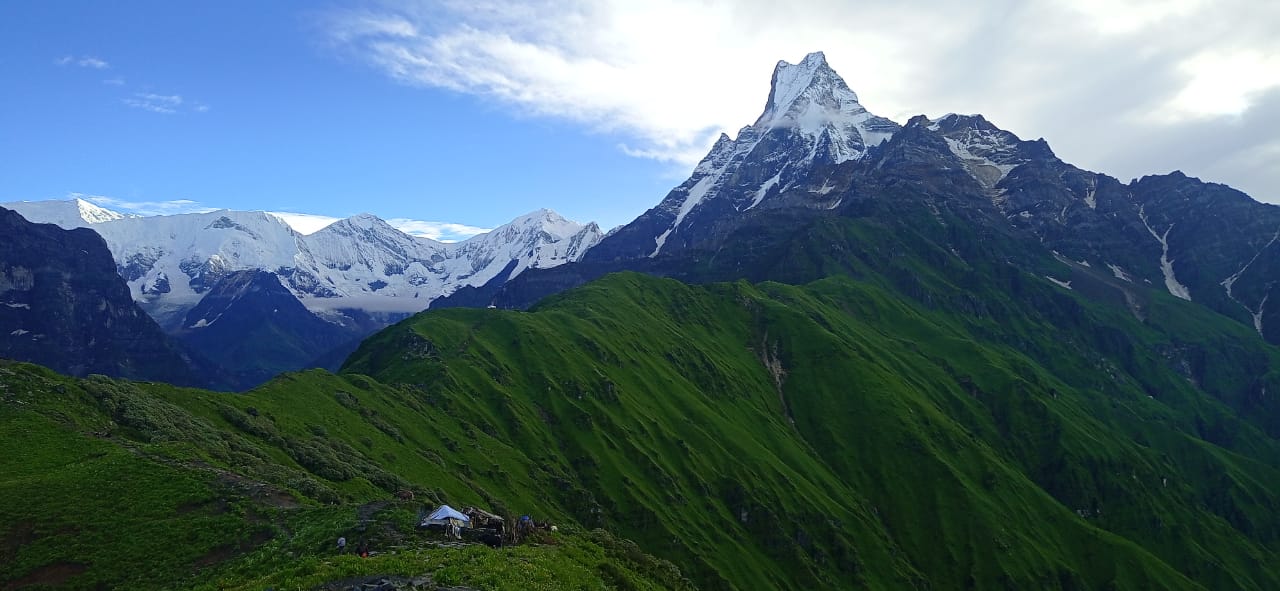MARDI HIMAL BASE CAMP TREK
Because so few hikers make it to Mardi Himal’s Base Camp, the Mardi Himal Base Camp Trek, located just east of the Annapurna Base Camp route, is a hidden gem. The trail winds along tiny trails among ancient rhododendron trees until you reach 3,300m. The environment changes considerably here, with stunning views of the Mardi Himal, Machhapuchhare, Annapurna South, and Hiunchuli. From High Camp (3,580m), it takes around 3-4 hours to reach Mardi Himal Base Camp, which offers stunning up-close views of the entire Annapurna Range. A beautiful viewpoint is also nearby, around two hours from High Camp—one of the Mardi Himal trek’s most tantalizing hidden secrets.
Along the way, you may come across beautiful stone cottages, magnificent teahouses, and rock cairns. As a result, it is a popular substitute for Annapurna region excursions such as the Annapurna base camp and the circuit walk.This is an amazing insight into the biodiversity of the mountains since steep-sided valleys, forests covered in rhododendrons and bamboo, ridge walking, and the variety of flora and wildlife are all unique to the Himalayas. High Camp (4,100m) is the highest point on the trail, while Low Camp (3,150m) is the lowest. If there is more time, the duration of this voyage can be prolonged.
This is a fantastic walk for people with limited time and a desire to explore more remote areas! The Mardi Himal trek is the best option for travelers on a tight schedule who want to see the stunning magnificence of the Annapurna region. It is a wonderful alternative for beginners getting their feet wet in the world of trekking, similar to the Mardi Himal Base Camp trek, which is shorter and easier but still provides a true trekking experience as you ascend 4500 meters in just a few days.
This short walk is suitable for both new and expert hikers. It is recommended to trek through lush forests and high alpine pastures to reach the Mardi Himal View Point, which offers breathtaking sunrise views of Annapurna and Machhapuchhre’s snow-capped mountain peaks. The Mardi Himal Base Camp Trek path has a few simple lodges and tea shops, making the journey more doable. What could be more exciting than an unexplored trail with amazing views?
HIGHLIGHTS – MARDI HIMAL BASE CAMP TREK:
- Spectacular and inspirational mountain views
- Scenic and lush Rhododendron Forests:
- Cultural Immersion and heartfelt hospitality
- Off-the-Beaten-Path
- Varied and unique Terrain
- Various types of flora and wildlife
- Teahouse Accommodations
- Safety and Well-Marked Trails
ITINERARY- MARDI HIMAL BASE CAMP TREK:
Day1: Drive to Pokhara(820m) (7-8 hours)
Following an early breakfast, we’ll board a tour van to Pokhara. Travelling by bus will take approximately six to seven hours. On the journey, you’ll see the beautiful Marsyangdi and Trishuli rivers. Pokhara, a picturesque valley on the shores of Phewa Lake, is well-known for its panoramic vistas of the Annapurna mountains, especially Machhapuchhre, Dhaulagiri, and Lamjung Himal.
Day 2: Pokhara to Dhampus (1640m) (drive) and then trek to Deurali (2100m).
We’ll drive two hours early in the morning to Dhampus, where the trails begin. While passing through colourful settlements, the ascent provides vast views of the Annapurna ranges. We continue through the woodland and rhododendron till we reach Pothana and finally Deurali (2100m). From the settlement of Deurali, you can see the tall glaciers on one of the most towering Himalayan peaks, Annapurna South.
Day 3: Trek from Deurali(2100m) to the Forest Camp(2600m):
We leave Deurali early in the morning for Forest Camp. The path gradually ascends through a woodland of the rho, birch, oak, and hemlock. Along the way, you encounter leopards, deer, monkeys, and a variety of bird species. We will spend the night in Forest Camp.
Day 4: Trek from the Forest Camp to High Camp(3600m) (4-5 hours)
Today’s trek will take us from Forest Camp to High Camp via Low Camp. Although the paths are difficult, the views of Mardi Himal, the Annapurna Base Camp valley, the Annapurna Range, and Machhapuchhre (fishtail mountain) are beautiful.
After several hours of walking, a clearing in the forests allows you to see the face of Annapurna South. The path then splits into a section of ragged woodlands. As we approach the mountain, you can look down into the valleys. To your left will be the Modi Khola River valley, which is surrounded by settlements that rise to the Annapurna Sanctuary. To our right are the Modi Khola and Seti river valleys. On good days, you can even see the Pokhara Valley. We keep climbing until we reach High Camp (3900m), where we spend the night.
Day 5: Trek from the High Camp to the Mardi Himal base camp(4500m) and Low camp (6-7 hours)
We get up early in High Camp to catch the incredible sunrise views of the enormous Himalayas. Then we’ll climb the difficult ridge to the 4500-meter Mardi Himal Base Camp. As seen from Mardi Himal Base Camp, the light is blazing on the full face of Annapurna South, with Fishtail Mountain immediately overhead. After seeing the Mardi Himal Base Camp, we will continue our journey to Low Camp.
Day6: Trek from Low Camp (3,050m)to Jhinu Danda (1780m) (6-7 hours)
As we descend from Low Camp, we follow a difficult path through the forests. After an hour of hiking, we arrive at a huge clearing where we will have a break. However, we continue to descend to Siding, a mountain town 500 metres above the river valley. As it descends, the trek goes past the Gurung village of Landruk. We may decide to stay in Landruk or travel to Jhinu Danda, depending on the conditions. We can relax our tense muscles in the natural hot springs at Jhinu Danda.
Day7: Jhinu Danda/Landruk to Siwa/Ghandruk Phedi (1,150m) drive to Pokhara (820m) via Nayapul (1050m) (trek 3-4 hrs.’) (driving 3-4 hrs.)
We have arrived at the last day of our trek. To get to Siwa/Ghandruk Phedi, we take a beautiful walk along the Modi River today. After saying goodbye to the trails, we returned to Pokhara via a scenic drive across the countryside.
Day 8: Departure to Kathmandu.
This day, you bid farewell to Pokhara and reminisce all your trekking memories on the way to Kathmandu.
USEFUL INFORMATION:
ACCOMMODATION AND FOOD
In Pokhara and Kathmandu, you’ll stay in a three-star hotel. Throughout the road, the teahouses that simultaneously function as hotels and guesthouses constitute the backbone of this arrangement. After a long day of climbing, these lovely inns welcome you with open arms and provide necessities such as comfortable mattresses and common restrooms. The lodgings are modest, but they provide necessary shelter in the Himalayan climate. Rooms can be shared or private, depending on preferences and availability, and each one provides an opportunity to unwind and replenish. Even though blankets are available, it is recommended that you bring a sleeping bag for increased warmth and comfort.
While on the journey, you can choose your meals from the menus supplied by the neighbourhood tea shops. Sherpa stew, fresh vegetable items, noodles, various soups, homemade bread items, rice items, spaghetti, pizza, eggs, potatoes items, Apple pie, Dal Bhat, and a range of beverages such as black tea, lemon tea, hot chocolates, and ginger tea are among the menu items. They also offer a variety of ethnic cuisines as well as Western-style dishes.
You can expect a well-planned food arrangement that takes into account dietary needs as well as regional delicacies while on the Mardi Himal Trek. Please keep in mind that teahouses may not always have a specific item in stock due to location and season.
ELECTRICITY AND WATER:
On the trekking trail, there is water nearby. Mineral water can also be purchased nearby. Nonetheless, we recommend that you avoid purchasing water bottles because they clutter the route. Fill your water bottle at any of the numerous taps along the route, sterilise it with a pill, and drink it. As a result, we recommend that everyone bring a water decontamination tablet with them.
Of course, electricity is present. Low elevations allow you to charge your phone and camera batteries, and high summits have solar electricity. They will, however, charge a few dollars for things such as Wi-Fi, hot baths, and battery charging.
GEARS AND TYPES OF EQUIPMENT:
Here are some of the gear and pieces of equipment that are mandatory while trekking to the base camp:
- You first need a rucksack with a waterproof cover (30-35 litres capacity) to store other necessities.
- Hiking boots: Since this journey will have steep trails, a pair of comfortable and lightweight hiking boots is essential.
- Hiking pants: These hiking pants include additional side pockets and can be folded into knee-length shorts.
- Yoga pants or waterproof pants will make your walk more comfortable. Choosing to wear two layers will help you stay warm.
- Thermal tops and bottoms should be thick enough to keep you warm but flexible enough to allow for natural movement.
- Shorts
- T-shirts
- Wind/waterproof jacket
- Socks: 4-6 pairs
- Underwear: 4-6 pairs
- Sunglasses and sun hat: Essential for protecting your face and neck from direct sunlight
- Sun protection cream
- Lip balm
- Woolen cap: Necessary to protect from cold.
- Inner and outer gloves
- Headlamp
- Power bank/extra batteries
- Wet wipes/hand sanitizers
- Towel
- Rubber sandal
- toiletries
- Reusable water bottles and water purification tablets
- Sleeping bag
- You rarely find ATMs on the trekking trail. So, it is best to carry cash.
- Camera
Mardi Himal base camp trek – Conclusion:
This breathtaking trip pays homage to the outstanding natural beauty and rough terrain of Nepal’s Annapurna region. With a peak elevation of over 4,500 metres (14,764 feet) at Mardi Himal Base Camp, this journey offers hikers a unique opportunity to admire the splendour of the Himalayas without having to struggle with the crowds that are common on more popular routes.
Finally, the Mardi Himal Base Camp Trek is a one-of-a-kind adventure that allows trekkers to completely experience the Himalayas’ majesty while discovering a diversity of natural environments and cultures. This journey provides travelers with a true sense of Nepal’s natural and cultural richness, making it an unforgettable experience.
FAQs:
- What is the best time to undertake the Mardi Himal Base Camp Trek?
The best seasons for the Mardi Himal Base Camp Trek are spring (March to May) and fall (September to November). These months provide consistent weather, bright skies, and mild temperatures, making trekking more pleasurable and safe.
- How difficult is the Mardi Himal Base Camp Trek, and what is the required fitness level?
The hike is rated as moderately difficult. Trekkers should be physically fit and prepared to walk both uphill and downhill.
- What is the duration of the Mardi Himal Base Camp Trek?
The journey usually takes 7 to 10 days, depending on the itinerary and the trekker’s pace. Some choose shorter or longer routes to alter the duration.
- What permits must you obtain for the Mardi Himal base camp trek?
You will need two permits: The Annapurna Conservation Area Permit (ACAP) and the Trekker’s Information Management System (TIMS) card.
- Is altitude sickness a concern on the Mardi Himal Base Camp Trek?
While the maximum height of Mardi Himal Base Camp is lower than on some other hikes, altitude sickness is still a possibility. It is critical to acclimatize properly, stay hydrated, and be mindful of symptoms. It is vital to descend to lower elevations if symptoms increase.




